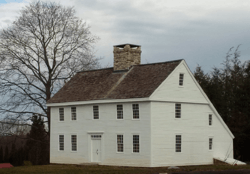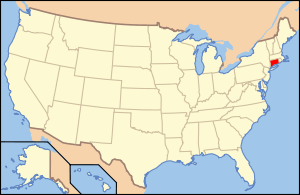Nehemiah Royce House
The Nehemiah Royce House, also known as the Washington Elm House, is a historic home located at 538 North Main Street, Wallingford, Connecticut. George Washington visited the house twice. In 1775, while on his way to take command of the Continental Army in Cambridge, Massachusetts and again in 1789 when he gave an address to the townspeople in front of the house near the Elm.
Nehemiah Royce House | |
 Nehemiah Royce House | |
  | |
| Location | 538 N. Main St. Wallingford, Connecticut |
|---|---|
| Coordinates | 41°27′59″N 72°48′48″W |
| Built | 1734 |
| Architect | Richard Henry Dana, Jr.; J. Frederick Kelly |
| Architectural style | Colonial |
| NRHP reference No. | 98000966[1] |
| Added to NRHP | August 24, 1998 |
Biography of Nehemiah Royce
Early life
He was Christened on 30 May 1637 (actual birth date unconfirmed), in New London County, Connecticut, the son of Robert Royce (c. 1606–1676) and Mary Sims. He died on November 1, 1706 at New Haven, Connecticut and is buried in Center Street Cemetery, Wallingford, Connecticut[2]
Marriage and family
On Nov. 20, 1660, he married Hannah Morgan at New London New London County, Connecticut. They were the parents of nine children. She was born on July 18, 1642 at Roxbury, Suffolk County, Massachusetts and died on June 19, 1677 at Wallingford, New Haven County, Connecticut. She was the daughter of James Morgan and Margery Hill. Royce, a carpenter, joiner and blacksmith by trade, was one of Wallingford's original 38 proprietors authorized by the Connecticut General Assembly in 1667 to purchase land from Mantowese and Sunk Squa, daughter of the Great Sachem of the Quinnipiacs. On May 12, 1670, Wallingford was incorporated and about 126 people settled in the town. On May 11, 1693 Royce was elected deputy representing Wallingford to the Court of the Connecticut Colony.[3]
Descendants
Nehemiah Royce's descendants number in the thousands today. Some of his notable descendants include:
- Jonathan Brace,[4] (1754–1837) was a United States Representative from Connecticut. He was born in Harwinton, Connecticut and graduated from Yale College in 1779.
- Clint Eastwood,[5][6] American film actor, director, and producer
- Millard Fillmore,[6] (1800–1874) was the 13th President of the United States, serving from 1850 until 1853 and the last member of the Whig Party (United States) to hold that office.
- Oliver Wolcott Gibbs,[7] was an American editor, humorist, theatre critic, playwright and author of short stories, who worked for The New Yorker magazine from 1927 until his death in 1958.
- Hamilton Jeffers,[7] (1893–1978) was a noted astronomer.
- John Robinson Jeffers,[7] (1887–1962) was an American poet, known for his work about the central California coast. He is considered an icon of the environmental movement.
- George B. McClellan,[8][9][10] Civil War general, Governor of New Jersey, Democratic opponent of Abraham Lincoln in the 1864 United States presidential election.
- Frederick Law Olmsted (1822–1903) was an American journalist, landscape designer and father of American landscape architecture, famous for designing many well-known urban parks, including Central Park in New York City.

==House==The Royce house is an example of American colonial saltbox architectural style[11] George Washington visited the house in 1775, when he was on his way to take command of the Continental Army in Cambridge, Massachusetts (he passed through Wallingford again in 1789). He stopped in Wallingford to purchase gunpowder from a nearby mill and addressed the residents of the town in front of the house near the Elm.
The Royce family occupied the house for over 200 years. The house was moved to its current location in 1924. For a time it was a museum and then was used as a residence by Choate Rosemary Hall, until the school donated the house to the Wallingford Historic Preservation Trust in 1999. It is listed on the National Register of Historic Places.
Architects Richard Henry Dana IV and J. Frederick Kelly and other architectural historians assisted in the restoration of the house.[12]
See also
Notes
- "National Register Information System". National Register of Historic Places. National Park Service. March 13, 2009.
- Nehemiah Royce at Find A Grave
- Colonial Connecticut Records 1636-1776
- "Memorials of Connecticut Judges and Attorneys, Jonathan Brace". Connecticut State Library. Last Revised: 02/08/2010. Retrieved 2010-03-08. Check date values in:
|date=(help) - McGilligan, Patrick. Clint: The Life And Legend; New York: St. Martin's Press, 2002; pp. 13.
- Roberts, Gary Boyd (December 6, 2002). "The New England Ancestry of Clint Eastwood". Retrieved 2010-03-08.
- Reitwiesner, William Addams (2007). "Ancestry of George W. Bush". Retrieved 2009-07-24.
- Jones, 16
- Jones, 19
- Jones, 20
- Connecticut: A Guide to Its Roads, Lore and People Federal Writers Project, US History Publishers, 1973.
- David F. Ransom and John F. A. Herzan (October 1997). "National Register of Historic Places Inventory-Nomination: Nehemiah Royce House". National Park Service. and Accompanying seven photos, exterior and interior, from 1996
References
- Jones, Emma C. Brewster. The Brewster Genealogy, 1566-1907: a Record of the Descendants of William Brewster of the "Mayflower," ruling elder of the Pilgrim church which founded Plymouth Colony in 1620. New York: Grafton Press. 1908

